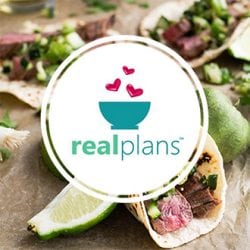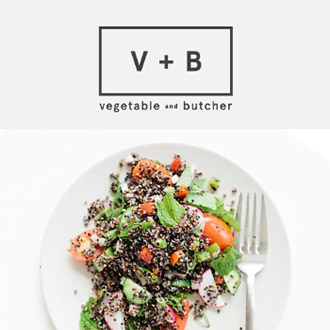This year, I went to the NatProdExpo for the second time.* It’s in Baltimore, an easy jaunt from DC, and if you’re a foodie, it’s THE place to check out new food trends, sample everything from ice cream to hemp seeds, and hear interesting speakers on topics from “The Real Reason We Need GMO Labeling” to “The Importance of Nutrition for Behavior, Learning and Mood.” And as a bonus (for me, at least) – it’s not just food! They have health and beauty products, kitchen products, laundry products, and everything in between.
So, what’s a “natural” product?


Certified Piedmontese Beef Color Maker, Inc
Really, almost anything. Because the term “natural” isn’t specifically defined and yet is still favorably received by customers, everyone co-opts it. The food section features everything from natural steak to natural food coloring (pictured above), and there were too many gluten-free, GMO-free, dairy-free, nut-free, animal-free products to count. The conference is billed as the “largest natural, organic and healthy products event,” and there’s definitely a strong health angle, but it’s important to bear in mind that what IS in a product is more important than what it’s “free” of. There were more than a dozen candy companies represented there, including Jelly Belly’s (they’re organic). My gauge of the healthiness of a food is nutrient density – the amount of vitamins/minerals per calorie – and through that lens, a huge chunk of the food companies wouldn’t make my list of “things to consume regularly and frequently.” Here’s a brief roundup of products that caught my eye!
Product Review

Michele’s Granola – a friend of mine introduced me to this granola company, and I have to say I’ve really never tasted better. Somehow they get it light and crisp and crunchy without being too hard…as much as I tried, their representative wouldn’t tell me the secret to getting it this way! It’s pretty low in sugar, and the first 5-6 ingredients are oats, coconut, nuts, and seeds. My only critique: they appear to only use canola oil; I’d like to see more variety in that department! This pic is of their new Muesli product, their version of the traditional German breakfast dish.


Manitoba Harvest – I’ve had their hemp seeds (which are a fantastic addition to yogurt, oatmeal, smoothies, baked goods, etc), but they have new bars out, and they’re pretty good! 10g of protein and 3g of fiber, with only 9g of sugar despite the fact that that’s high on the ingredient list (I always look for a 3:1 sugar:fiber ratio to make sure my blood sugar won’t be spiking after eating!). At 240 calories, this would make a nice afternoon snack, or couple well with a piece of fruit for a light breakfast.

Bob’s Red Mill – oats, quinoa, chia seeds…and dozens of other products that even “regular” grocery stores carry under this brand. They’re branching out with some new to-go oatmeal cups and even pea protein powders, items I’m not usually a huge fan of, but their staples are tried and true, and Bob himself comes in his cute hat to meet people at the expo. I skipped that because I did last year, but how cool is that?

Fage Yogurt – I’m always looking for WHOLE greek yogurt that’s strained (not thickened with gums, starches, or powders), and it’s getting a little easier to find. My go-to is plain, but with these new whole-fat flavors I couldn’t resist! Flavored yogurts tend to be mostly sugary and I view them more as a treat than a staple, but Fage totals have a reasonable balance of fat, protein, and sugar.

Perfect Pickler – this, I love. It’s a home pickling kit that takes the guess work and cooking/canning aspects out and puts some healthy probiotics IN. The only problem I see here is that I’d want to do more than one jar at at time, but if you make a jar a week (it takes a few days at room temp for them to be sufficiently pickled) you’d have lovely add-ons for sandwiches, salads, and soups for a family very easily. Kim-chi me!
Educational Sessions
“Changing Diets, Changing Minds: The Importance of Nutrition for Behavior, Learning and Mood Presented by: Carlson Labs“
Dr. Alex Richardson is a very engaging [woman!] professor at Oxford, and spoke primarily about the importance of omega-3’s for mental health. Her presentation was very well laid out – she had the audience on the edges of seats as she described the typical amounts consumed, the problem with having such a vegetable-oil heavy fatty acid supply, and how getting enough DHA/EPA has implications for everything from learning to read to maternal post-partum depression. She showed this slide, which is imaging of the neural connectivity of a child’s brain whose mother did and didn’t get enough omega-3 during pregnancy, respectively:
In this case, you are what your mother eats, and many mothers aren’t making sure their balance of omega-3 to omega-6 is at the right level! I’m a huge proponent of eating a variety of fats (instead of avoiding fat), and Dr. Richardson emphasized the importance of fatty fish to meet the levels (nuts and seeds have some omega-3’s, but unfortunately not in the form that is most potent in the body). She also noted that the previous recommendation for pregnant women to eat a maximum of 2-3 servings of fish per week is now the target amount, because the benefit of the fish outweighs the risk of mercury poisoning, especially if you focus on certain types of fish.
On the downside (for a food-first dietitian), despite noting that healthy levels of omega-3 are achievable through diet alone, her emphasis was on using supplements to make up for deficiencies. No surprise really – the talk was sponsored by Carlson Labs, who make supplements – but my recommendation would be to
1) look to changes you can make in your diet first (fish 2-3 times/week)
2) get blood levels of omega-3’s checked
3) supplement only after 1 and 2 prove to be inadequate.
Ask your doctor if he/she can order that test, especially if you don’t eat fish or are pregnant or trying to become pregnant.
“Non-GMO Series: The Real Reason We Need GMO Labeling“
Presented by Gary Hirshberg, the founder of the “Just Label It” movement (and former dairy farmer, I was surprised to learn!), this was the most interactive talk I went to. Gary is a compelling speaker, very smart, and laid out the reasons for his campaign with clarity and passion.
I went into this session as someone opposed to Genetically Modified Organism (GMO) labeling, for the following reasons: GMO technology (by itself) has not been shown to have health implications for human consumption, people are confused enough by labels as it is (why add one more that doesn’t indicate health or lack there of?), and it could steer people away from healthy foods (GMO vegetables) and toward those that aren’t (non-GMO cookies). Also, plants and animals that are certified organic can’t contain GMO’s by law – so there you have a way to choose non-GMO if you want!
Getting the full story on any issue you want to “take a side on” is crucial, so I’m so glad I went to this talk – I learned so much, and understand more nuances of the situation than I’d thought about initially. Gary’s primary reason for starting this campaign is to strike a blow at one of the most pervasive uses of GMO technology: herbicide usage. There’s a crucial distinction here that most people don’t fully realize – GMO technology and herbicide/pesticide technology are two separate things. Genetic modification of an alfalfa plant that allows it to be unaffected by herbicide and application of said herbicide are separate steps. Got it? So, in this particular instance of use of GMO technology, herbicide use in our country skyrocketed. (That jump is even mostly attributable to a single GMO modification in a single plant: soy.) When that happened, the only weeds that survived were the toughest weeds, and adapted to become resistant to herbicide, which then necessitates bigger doses or stronger herbicides to kill. Basically, in an arms war with nature, nature is always going to win in the end. The best way to farm is to work with the land, not against it – Mother Nature will genetically modify with sample sizes and a level of mastery humans can’t compete with!
So, back to the labeling. Why label? Why not just attack the use of herbicides that cause resistant weeds and is dangerous for people to breathe and eat? Someone asked that question, and sadly the answer came down to: legal tactics and money. The Just Label It organization has only tens of thousands of dollars to put against multi millions of the food and ag companies, so they’re trying to get them to change though public/consumer pressure, knowing that most manufacturers will not want to put the two words “genetically modified” before ingredients on their food labels. (I was glad to learn that they’re only pushing for a bid to add that in the ingredient list, and not create a new front of package label – although there’s a certification that has taken this route from the GMO-Free side.)
Here was the real surprise to me: Gary himself isn’t actually “anti-GMO.” I went up to talk to him after he finished speaking, and asked about what he thought of the use of GMO technology for purposes other than herbicide resistance. What if the technology was used to reduce harmful compounds in foods (like acrylamide in potatoes) or enhance positive ones (like beta-carotene in rice) or make a crop resistant to bugs without the use of pesticide application (as in Bt eggplant)?** I’m not going to quote him directly, because I didn’t record and I wouldn’t want to get it wrong, but Gary said that with the proper testing for safety for consumption and environmental impact, genetically modifying food might prove to have merit (and he was actually the one who pointed me to the potato example, saying, “that’s interesting”). If a food company wants to enhance a food by genetically modifying it, they should be transparent about what and how they’re doing, and use the “GM” label as a jumping off point for a conversation and education about the process.
To be honest, I’m still not sure if I’ll sign the Just Label It petition. I’m glad I’m a lot more aware of their cause and its roots, and I’m all for transparency in food production, but I worry that being “GMO” will become equivalent to “bad for you” in a permanent way, when only some applications of the technology are problematic. Requiring transparency of how safety and efficacy trials are conducted should be part of the solution. I view this the same way I do computers, or automobiles – it all depends how you use it, and how well you test it; anything can be applied to make life better, or to hurt people and cause destruction. It’s a big, complicated topic, and I welcome any questions or insights you may have! Overall, I had a fantastic time at the Expo, and hope to go back next year. Thanks for reading about my experience!

Join me on Instagram as I take a romp through all things food and pottery!
*I attended the Expo free of charge as a blogger. I was not paid to attend and received free samples from the vendors I chose to write about.
**The articles linked to here are also excellent for exploring the issue of GMO technology as a whole, and do a good job of addressing all sides of the issue












